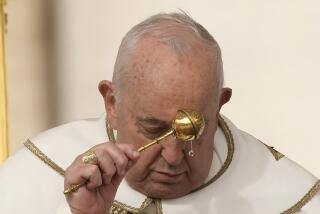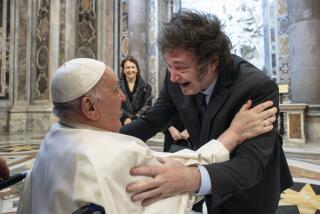Pope has agenda of hope
In his first pilgrimage to the United States as pope, Benedict XVI will minister to a Roman Catholic Church that is both troubled and alive with faith.
From the Vatican, the church in America is often seen as problematic, consumed by sex abuse scandals and populated by “cafeteria Catholics” who pick and choose the religious rules they want to follow, casually adjusting doctrine to meet the demands of their busy lives in an overly permissive society.
But Benedict sees a dynamic church, one that has navigated with fair success the maze of living a faithful life in a secular, materialistic world. For him, the church in America is less a challenge and more a potential model, as is the growing role of religion in American society.
“From the dawn of the republic,” the pope said recently, “America has been . . . a nation which values the role of religious belief in ensuring a vibrant and ethically sound democratic order.”
Benedict, who arrives in Washington on Tuesday, hopes to use his six-day visit, which will include meetings with Catholic seminarians, educators and clergy, as well as two enormous open-air Masses, to stress the importance of God in daily life. He is also expected to touch on more sensitive topics such as war, abortion and human rights.
Benedict will also be on a mission to heal still-festering wounds: This is the first visit by a pope to the U.S. since pedophilia cases involving hundreds of priests came to light in 2002. And he will encounter a church that has undergone dramatic demographic change in the last decade, its parish pews filled thanks in large part to Hispanics and Hispanic immigrants, as is especially evident in Southern California.
“He will not be afraid to confront the challenges that confront us all,” Father David M. O’Connell, president of Catholic University of America, said in an interview. But, O’Connell added, “his message will be one that is very positive and encouraging, that focuses on the future, not simply examines the past. . . . The goal will be to lift up hope for American Catholics.”
“He’s not coming here to shake his fist at us,” said Father Thomas Reese, a senior fellow at the Woodstock Theological Center at Georgetown University.
In recent comments to the new U.S. ambassador to the Holy See, Mary Ann Glendon, the pope was full of praise for “the American people’s historic appreciation of the role of religion in shaping public discourse and in shedding light on the inherent moral dimension of social issues.”
Benedict rejoices in the presence of religious belief in U.S. public policy, in a government that isn’t reluctant to use the words “in God we trust” -- something that is not allowed in much of stringently secular Europe. Condemning secularism and advocating a return to Christianity’s core values have been the central themes of the German-born theologian’s 3-year-old pontificate. The increasingly religious nature of some segments of American society should make for an especially receptive audience for the pope.
“This is a pope who is very concerned about the loss of faith in Europe . . . but the U.S. is in a very different situation,” said Father Thomas Rausch, a theologian at Loyola Marymount University in Los Angeles. “All kinds of Christianity -- Catholic, Protestant and Orthodox -- are much more alive and vital than in Europe.”
The church in America is highly diverse, spanning the gamut of political opinions and socioeconomic situations. And it has a determined independent streak, with some followers’ bending of the rules putting them at odds with the Vatican. Some U.S. practices, such as women serving as hospital chaplains and the liberal use of altar girls, might be frowned upon in Rome. But that same independence also gives vitality to the American church.
Benedict and the Vatican are “obviously impressed with the engagement of American laity in the life of the church, in liturgy and social action,” Cardinal James Stafford, one of five Rome-based senior American prelates who will accompany Benedict, said in an interview.
He acknowledged, however, that surveys showing some Americans abandoning the church were “sobering” and constituted “a call for enormous self-criticism.”
“Parish life is still vibrant. Wounded, but vibrant,” Stafford said. “So there is hope.”
A recent study by the Pew Forum on Religion and Public Life reported that although nearly one in three Americans was raised in the Catholic faith, today fewer than one in four describes himself as Catholic. But because of converts and immigration, the overall percentage of the U.S. population that identifies itself as Catholic has remained stable.
Hispanics, born in the U.S. or elsewhere, now account for nearly a third of American Catholic adults, the Pew survey said. And the Hispanic share of the church is likely to grow; according to the study, nearly half of American Catholics under the age of 40 are Hispanic.
The rising numbers of Hispanic faithful, especially in the booming dioceses of the Southwest, present opportunities and challenges to the Catholic Church, especially with many parts of the U.S. suffering a shortage of priests.
“The church in the United States is undergoing a new wave of multiculturalism,” said Father Pedro Barrajon, rector of Rome’s Regina Apostolorum Pontifical University. Hispanics are joining generations of Italian, Polish and Irish Catholics, “bringing with them their own problems of poverty, integration and need for education,” he said. Hispanic Catholics also tend to be more traditional in their religious beliefs than Anglo Catholics, surveys show.
Although Benedict’s schedule does not focus on Hispanics or immigrants, he has recognized the Hispanic presence in the American church by choosing to deliver part of his opening message and other speeches in Spanish. He will probably speak about immigration, and he also recently named a new cardinal, Daniel DiNardo of Houston, who represents an archdiocese with a large number of Hispanics.
Benedict will meet at the White House with President Bush, inviting speculation over whether the pope will criticize the Iraq war, which he has long opposed. And he will deliver a major speech to the United Nations and pray at the site of the Sept. 11 attack in New York.
The most difficult issue, however, will be the clergy sex abuse crisis, in which thousands of youths were said to have been raped or molested. The cost of the scandal in the U.S. is more than $2 billion in legal fees and settlements to victims, including a $660-million settlement in Los Angeles.
Archbishop Pietro Sambi, the Vatican’s nuncio, or ambassador, to Washington, raised the possibility with the National Catholic Reporter newspaper that the pope would meet with victims while in the U.S. However he chooses to do it, Benedict will have to address the lasting trauma that the crisis inflicted on the church.
“I think he will say we must ask for forgiveness, but we must not let it paralyze us,” Barrajon said.
Catholic leaders say Benedict’s visit will allow Americans to become more familiar with a less well-known pope who has an image as the hard-nosed enforcer of church doctrine -- the job he held for nearly a quarter of a century.
Benedict’s style is the opposite of his charismatic predecessor, John Paul II. A theologian by training, Benedict is more reserved and intellectual. In addresses, he tends to focus on the power of Christ’s love and other deeply religious matters, but his messages are always layered and textured, with deeper meanings and wider implications.
“John Paul was trained as an actor. He loved being on the stage and had no problem with huge crowds and klieg lights,” said Rausch, the Loyola theologian. “Benedict is much more introverted. He’s quiet, gracious, courteous, rather diffident in his dealings with people.
“John Paul could woo crowds. Benedict tends to speak like a university professor, but I think he’s found his voice as universal pastor.”
--
rebecca.trounson@latimes.com
Wilkinson reported from Vatican City and Trounson from Los Angeles.
More to Read
Start your day right
Sign up for Essential California for news, features and recommendations from the L.A. Times and beyond in your inbox six days a week.
You may occasionally receive promotional content from the Los Angeles Times.







